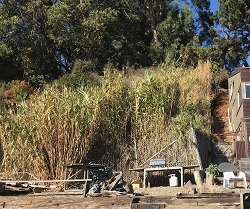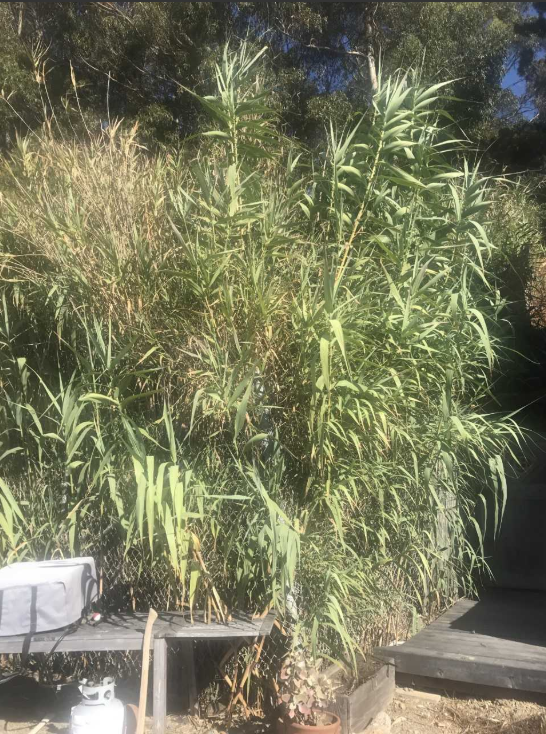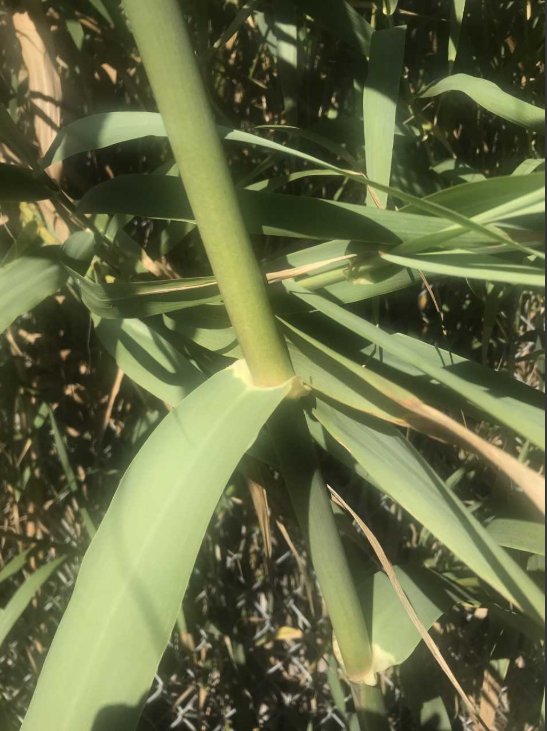"Bamboo" Problems
Advice for the Home Gardener from the Help Desk of the
UC Master Gardener Program of the Contra Costa County
MGCC HD Client's Request: I live in West County along the Bay. There is a very large patch of “bamboo” that I would like to identify so I can take the appropriate measure to eradicate it.
I'm calling it a “bamboo” until I know what it actually is. I have heard that it really isn't a bamboo and that it is invasive. It grows 12'-18' tall. The stalks are up to 1.25" diameter. It is so dense and there are a lot of aphids. It is a rhizome bamboo, not the clumping type. It has taken over and is spreading like crazy to the other side of our house.
Below are photos. One photo shows the big patch to the left of our house. The other 2 are close up images.

Giant Reed
MGCC HD Response: Thank you for contacting the UC Master Gardener Program with your questions about the large patch of “bamboo” next to your home. Your guess that it is not actually bamboo is correct, and from the very clear and helpful photos you sent we can identify it as the Giant Reed, Arundo donax. Actually, this plant is easily confused with bamboo as they look quite alike, and can spread and grow large. Bamboo leaves are attached to the stem, or culm by a short stalk, but your photos show a yellowish collar around the base of the leaf, which is characteristic of the reed. (see photo here https://www.sfei.org/nis/giantreed.html )

https://www.cal-ipc.org/resources/library/publications/ipcw/report8/
http://www.santaynezchumash.org/links/arundo_brochure.pdf
It will be quite an undertaking to eradicate this weed, and you will need some good friends to help!
We have some UC information on dealing with woody weeds, but the size of your infestation seems a little beyond this advice http://ipm.ucanr.edu/PMG/PESTNOTES/pn74142.html
We consulted with a biologist from the Contra Costa Agricultural Commissioner's office, and he was not aware of any programs to assist homeowners with the giant reed. You could begin to mechanically remove the plant material, but there will be re-growth from the stumps, and these would need to be treated with herbicide (see links for details) If you are close to water you would need to use a product approved for such areas.

We wish you all the best with this endeavor, please let us know how it turns out.
Help Desk of the UC Master Gardener Program of Contra Costa County (SMW)
*******************
HOrT COCO Editor's Comment: Unfortunately, this editor is well aware of Giant Reed. It is almost everywhere in the County. When moving into my bare dirt subdivision house in mid-County 50 years ago, I was scavenging any “free” plants I could find to start my garden. I “found” Giant Reed on a nearby empty lot that I thought was bamboo, dug some up and planted it on my initial hillside garden attempts. Several years later I found that it was Giant Reed from knowledge gained at my job when I observed big projects clearing Giant Reed from channels and creeks. Luckily for me, my hillside wasn't that fertile and I hadn't really watered it, so I started to remove it… still took three years of frequent and hard work to eradicate it. From the pictures submitted above, eradication will be a BIG job for this client.
Note: UC Master Gardeners Program of Contra Costa's Help Desk is available almost year-round to answer your gardening questions. Except for a few holidays (e.g., last 2 weeks December), we're open every week, Monday through Thursday for walk-ins from 9:00 am to Noon at 2380 Bisso Lane, Concord, CA 94520. We can also be reached via telephone: (925) 608-6683, email: ccmg@ucanr.edu, or on the web at http://ccmg.ucanr.edu/Ask_Us/. MGCC Blogs can be found at http://ccmg.ucanr.edu/HortCoCo/ You can also subscribe to the Blog (//ucanr.edu/blogs/CCMGBlog/)